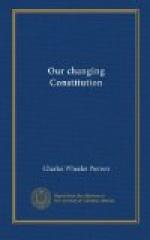Wherein, then, did the novelty and greatness of the Constitution lie? Its novelty lay in the duality of the form of government which it created—a nation dealing directly with its citizens and yet composed of sovereign states—and in its system of checks and balances. The world had seen confederations of states. It was familiar with nations subdivided into provinces or other administrative units. It had known experiments in pure democracy. The constitutional scheme was none of these. It was something new, and its novel features were relied upon as a protection from the evils which had developed under the other plans. The greatness of the Constitution lay in its nice adjustment of the powers of government, notably the division of powers which it effected between the National Government and the states. The powers conferred on the National Government were clearly set forth. All were of a strictly national character. They covered the field of foreign relations, interstate and foreign commerce, fiscal and monetary system, post office and post roads, patents and copyrights, and jurisdiction over certain specified crimes. All other powers were reserved to the states or the people. In other words, the theory was (to quote Bryce’s “The American Commonwealth”) “local government for local affairs; general government for general affairs only.”
The Constitution as it left the hands of its framers was not entirely satisfactory to anybody. Owing to the discordant interests and mutual jealousies of the states, it was of necessity an instrument of many compromises. One of the great compromises was that by which the small states were given as many senators as the large. Another is embalmed in the provisions recognizing slavery and permitting slaves to count in the apportionment of representatives. (The number of a state’s representatives was to be determined “by adding to the whole number of free persons ... three-fifths of all other persons.”) Another was the provision that direct taxes should be apportioned among the states according to population. With all its compromises, however, the Constitution embodied a great governmental principle, full of hope for the future of the country, and the state conventions to which it was submitted for ratification were wise enough to accept what was offered. Ratification by certain of the states was facilitated by the publication of that remarkable series of papers afterward known as the “Federalist.” These were the work of Alexander Hamilton, James Madison, and John Jay, and first appeared in New York newspapers.
One of the objections to the new Constitution in the minds of many people was the absence of a “bill of rights” containing those provisions for the protection of individual liberty and property (e.g., trial by jury, freedom of speech, protection from unreasonable searches and seizures) which had come down from the early charters of English liberties. In deference to this sentiment a series of ten brief




